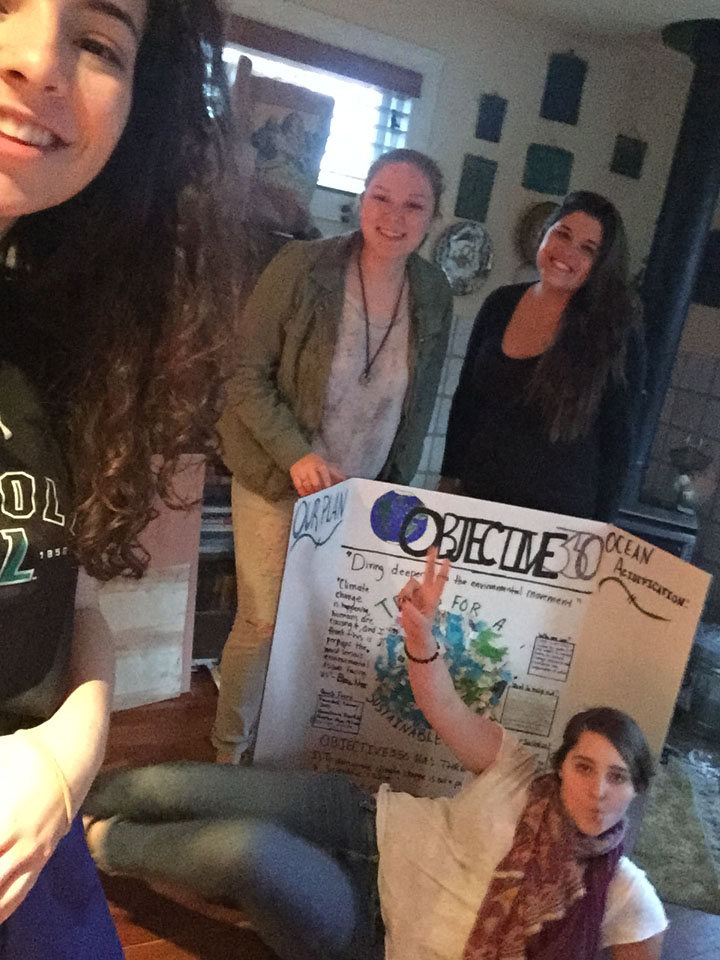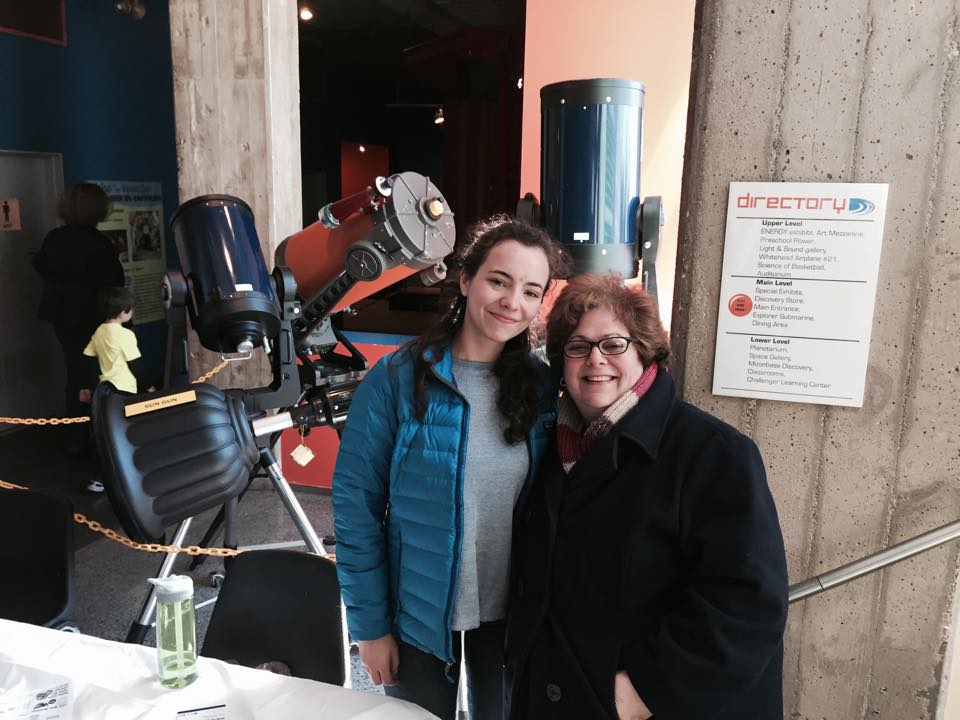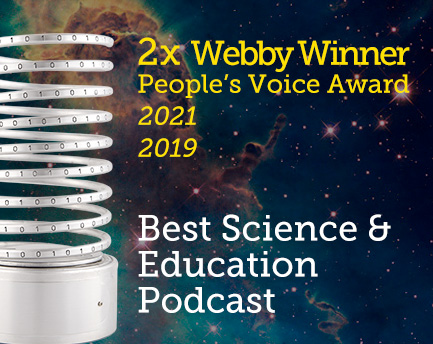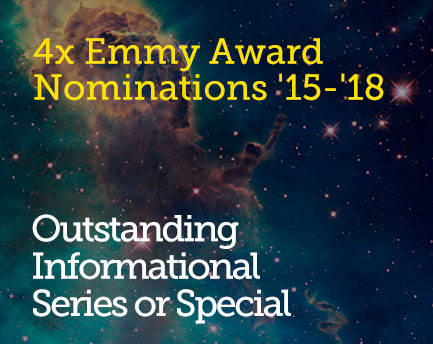May 20, 2015 8:00 pm
“How will I see the stars if things get worse?”
Not every teenager is apathetic about science and unwilling to get involved in addressing climate change. Here’s a guest post from Clare Burhenne, a Connecticut high school student/amateur astronomer who started Objective350 with a group of teens concerned about climate change. You can contact Clare and Objective350 via the links at the end of this post. And special thanks to our own amateur astronomer, StarTalk Radio Community Manager Stacey Severn, for bringing Clare to our attention.

Some of the members of Objective350 working on a poster for an Earth Day presentation. From left to right: Clare, Sarah, Emily, and Page. Credit: Clare Burhenne.
It was only a couple months ago that I approached friends from my hometown about helping me start an environmental research group and NGO (Non-Governmental Organization) that would later be dubbed Objective350. The band of misfits that resulted from my social media appeals is truly a wonderful bunch. They’ve all been willing to give up some of their time to help get students engaged in climate change and in the research surrounding it. This, I can assure you, has not been the easiest task. The facts surrounding climate change aren’t fun and the damage we’ve inflicted on the Earth doesn’t necessarily have a simple mitigation process, but my team and I believe that one important way to create positive change is to inform teenagers about climate change. Whether it be political policymaking, economics, or some good old fashioned environmental activism, Objective350 (affectionately referred to as O350) believes that there is a way to get our generation genuinely interested and passionate about preserving our Earth.
Quickly though, I have to acknowledge the blog-space that this post will occupy, StarTalk Radio; a place where science is made engaging, and dare I say it, fun. I am truly grateful to Dr. Tyson and the StarTalk team for giving the public a really cool way to enjoy space and science.
Making science fun, accessible, and interesting is actually the heart of this matter. It is Objective350’s goal to take science down from its proverbial pedestal and allow people to explore and discover what it has to offer. Science is not a spectator sport, indeed it begs for participation, and rightfully so; it’s one way to gain a deeper understanding not only of ourselves, but of our universe. Astronomy allows us to explore our cosmos, biology invites us to discover what we’re made of, and environmental studies challenges us to learn more about the Earth, our home. Better yet, despite the divergence of study in each field, there are always points of intersection.
For instance, my passion is astronomy. My visits to my local observatory, Rolnick at the Westport Astronomical Society, have proven that while it is simple to press your eye to a cold telescope and see the cratered surface of the Moon, it is nearly impossible to convey the emotion that it evokes. Emotion, passion, and intellectual curiosity are often the harbingers of change.

Clare pictured with StarTalk Radio Community Manager Stacey Severn. Credit: Clare Burhenne.
As I mentioned earlier, it is my belief that fields of science can diverge and converge as naturally as the tides; convergence, however, depends on that nagging need to “know more”. The individuals willing to conduct research, learn, and listen from others can be called “scientists”, a title that can be acquired regardless of age, gender, race, or religion, with the given stipulation that these hopefuls exhibit curiosity and integrable attitudes towards both their own passions, and science at large. That is the wonderful thing about the team of people I work with at Objective350. They have taken their initial passion, whether it be child education, chemistry or politics, and have somehow consolidated it with environmental studies. We are all bound by a deep concern for our Earth’s health and sustainability, but we are each driven by the reaction between our passion, science, and the facts of climate change.
As I mentioned before, astronomy is “my thing”. As a result I’m inclined to think about the big picture, and since the universe is almost as big as it gets, I’ll often consider my, and our Earth’s, place in the cosmos. Indeed the Earth is fragile, small, and ultimately, the only outpost for life that we know of. When I became involved in climate change activism it was that cosmic perspective that drove me. All my initial questions were admittedly selfish; I could think of very little except, “How will I see the stars if things get worse?” Without any other cosmic arena from which to marvel at the vastness of space, I was at a loss for an alternative. It was a save-the-Earth-or-bust kind of moment. It’s all very apropos and grandiose, but ultimately it was a helpful realization. With time, my concern grew beyond fearing reduced visibility at the observatory, and morphed into yet another “big-picture”. There are seven billion people on the Earth, and while not all the inhabitants consider it one huge planetarium, they do recognize it as their home.
The problem is that most people don’t innately recognize the Earth’s fragility. Which, when you think about it, is highly understandable. Compared to a human the Earth is a behemoth! Arguably, the most accurate representation of our world came in 1968 – the year Apollo 8 astronaut Bill Anders took his iconic Earthrise photo. Try and imagine the shock that photo caused the population- seeing their Earth suspended in a space, with the moon covering more than half of its surface. As a result of that picture, and a few more after that one, a whole new kind of environmentalism began, igniting legislation and activism that the world had never before seen. That fervor waned and environmentalists found that concern on such a large scale couldn’t be maintained by the space race and the information it produced. Unfortunately, the same goes for today’s modern world. Information moves quicker, news and pictures come to us in bite-sized pieces and people already know that the Earth is blue and green and that carbon dioxide is bad for the atmosphere. Communication is different, indeed society is different, and to create a sustainable worldwide “call-to-action” it was clear that Objective350 had to be a social-media based operation.

This picture of Earth, seen from Apollo 8 with the lunar surface in the foreground, changed how we think of Earth. Taken by William Anders, aboard Apollo 8, on December 24, 1968. Credit: NASA.
It is Objective350’s belief that teenagers are integral to mitigating the damage inflicted on our climate, partially because they are the next generation that will be voting for and writing legislation, and partially because they are so deeply engrained in social media. My team and I communicate with the public through platforms like Facebook and Twitter and offer clarifications and information through YouTube. In our series “Let Me Clear Something Up,” the O350 crew pick topics we think would benefit from a clarification and try to offer them to the public in an interesting way. We hope to use social media to get our hometown involved in testing the effects of predicted increased levels of carbon dioxide on its fresh water and organic matter, also known as fresh water acidification.
My team’s response to climate change may not be the most spectacular, but it does typify the tenacity and focus that my generation can demonstrate. And like I said earlier, my crew is by no means homogenous. We are indeed a lovable band of misfits, an amalgamation of passion and concern, that weird, blob of interdisciplinary convergence. We’re united under the cause that is the welfare of the Earth and driven by our individualism.
If Objective350 does nothing other than demonstrate that you don’t have to love science to be a scientist or to care about your Earth, then we’ll consider our time well spent. However, my team and I expect only good things for the future. We’re tackling only one aspect of “the-dilemma-that-is-climate-change”: the dearth of interested and informed teenagers. While this in and of itself is a rather daunting challenge we believe that having a clear focus and a true passion for what we’re doing will help incite others with a passion for positive change. We’ll keep working to start a conversation until no one wants to talk anymore, and then we’ll simply take to Twitter and start anew. Whatever the case may be, we’re looking towards the future, and we’re shooting for the stars.
Thank you for your time, here are some links to our social media outlets:
Website: www.Objective350.com
Facebook: www.facebook.com/Objective350
YouTube: www.Youtube.com/Objective350
Twitter: www.Twitter.com/Objective350
Feel free to contact me through Facebook as well:
www.facebook.com/clareburhenne
Get the most out of StarTalk!
Ad-Free Audio Downloads
Priority Cosmic Queries
Patreon Exclusive AMAs
Signed Books from Neil
Live Streams with Neil
Learn the Meaning of Life
...and much more

 Become a Patron
Become a Patron

